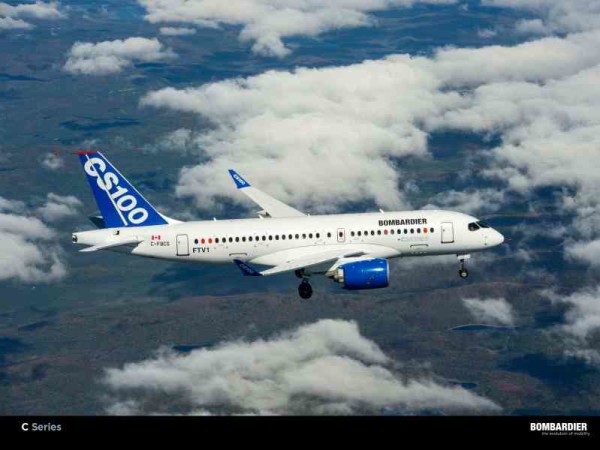Delta Gives Bombardier A Big Boost With A Home For The C Series
Delta announced late last week a large order for Bombardier’s C Series, a plane that’s had a lot of trouble getting off the ground. The order is for 75 firm orders and options for an additional 50 of the CS100, the first C Series plan to roll off the assembly line. I had seen it written earlier that Delta also has the option to convert some of these orders into the larger CS300. Why is this significant?
I first learned about the C Series about 5 years when I participated in StarMegaDO 3, a crazy excursion for aviation enthusiasts. As a volunteer organizer, we chartered a plane and flew to Montreal to visit with Bombardier. At that time, the C Series was mostly concept. They had a few hunks of metal that would become the initial airframes and some displays outlining what they envisioned this plane would look like. They had a grand plan for a comfortable, fuel-efficient aircraft that would span the gap between 75 seat and 150 seat aircraft.
Since then, they’ve struggled mightily to get orders for the plane. There are a number of reasons, including fierce competition from Airbus and Boeing on new orders from a pricing standpoint. They also had their fair share of delays getting the plane to market. And, given the rough number of passengers the CS100 can hold (just over 100), it’s problematic for the US market since the FAA mandates an extra flight attendant when you add seat number 101 to an airplane. To maximize labor cost, US-based airlines want to focus on planes that are 99 seats versus 101 (or 149 v 151). That made it a tougher sell in the US.
There are pluses for Bombardier, Delta and the flying consumer with these new aircraft.
Bombardier is thrilled to have Delta place the largest current order for C Series aircraft. They’ve had massive financial issues due to cost overruns and delays, requiring them to seek funds from pretty much any available source. An order like this gives them some supply chain certainty, the ability to forecast for better productivity.
It also provides some cash, though likely not much since they probably had to strike a pretty good bargain to convince Delta to buy. Finally, it gives them some legitimacy. Most of the orders they have now are from much smaller airlines. Delta adds credibility to a project rife with uncertainty.
Delta leveraged the desperation that Bombardier faced to land a large order, likely landing a great price for these planes in the process. The list price is around $45 million, though there are rumors that Delta paid closer to $25 million, a number below their actual cost to build the plane. They get fuel-efficient planes (and the price of gas will go up at some point) with a pretty awesome range.
Delta’s CEO, Richard Anderson, is quoted as saying, “With 110 seats, the plane will fly nonstop from Atlanta to Seattle, he said. “It opens up a lot of opportunity,” he said.” The range of the plane is listed at 3,100 nautical miles, meaning the plane can fly any route in the continental US and is perfectly capable of travel to South America and maybe even London (from the East coast), though I don’t think it has ETOPS certification long enough to make a TATL voyage viable just yet.
Customers get a plane that offers some key passenger experience elements. For starters, the overhead bins hold up to 3 roller bags each. The specs are actually larger than a standard carry-on roller bag, advertising bags up to 24″ x 17″ x 11″. Whether airlines let customers bring bags that big onboard remains to be seen, but these bins will certainly hold a lot more bags than the overhead bin on any regional jet and more per passenger than some of the smaller and older narrow-body jets like the MD-80. My understanding from my visit up to the Montreal factory years ago was that the bins came as a standard option, in that airlines couldn’t choose a less roomy bin to save money.
Customers also get some key comfort elements including cabin noise levels and a 2-3 seating arrangement as opposed to a 3-3 seating arrangement, meaning less middle seats. And, given the width of the fuselage, it would be difficult (though not impossible) for an airline to go to 6 across in coach.
Finally, the range and fuel efficiency of the plane means that customers could end up with more nonstop routes to places farther away. Similar to the 787, which makes “long, thin” routes available, the C Series could theoretically be used to add trans-continental flights on schedules where demand might be lighter.
Bottom Line It For Me, Ed
The Delta C Series order is a big plus for Bombardier and could ultimately be a big plus for consumers. Comfortable planes that are cheap to operate with long-range could open up access to more routes. Fuel is bound to go up in price at some point and planes like the C Series will give an airline a distinct cost advantage. Airbus and Boeing don’t currently offer something in the 110 seat range, so the CS100 bridges the gap between regional jets and narrow-body jets for the moment.
As the larger CS300 becomes a reality (or an airline tries to squeeze an extra 10 or 20 seats on the CS100), these planes will begin to compete directly with Airbus and Boeing. Competition is already pretty stiff between Boeing and Airbus. Price is driving most orders and Boeing has entered a full-blown cost-cutting mode, renegotiating contracts with suppliers and eliminating jobs. Even though this order is a huge boost of confidence for Bombardier, they still have an uphill battle to get the C Series program on solid footing. But, it’s no longer a mountain.
The post Delta Gives Bombardier A Big Boost With A Home For The C Series was published first on Pizza in Motion.

